Top 11 Most Beautiful Fishes in The World
Fish is an animal that is familiar and close to humans. Besides being used as food, many fish species are also used as ornamental fish because of their beauty. ... read more...Let's find out with Toplist the most beautiful fishes in the world!
-
One of the most beautiful fishes in the world is the lionfish which is well-known around the globe for its distinctive beauty. They stand out due to their stunning colors and striped bodies with sharp, poisonous fin rays. For humans, lionfishes can result in severe pain, fever, vomiting, nausea, heartburn, diarrhea, numbness, and breathing problems. Rarely, a lionfish sting can result in temporary paralysis of the limbs, heart failure, and even death. However, it most frequently affects small children, elderly people, and people with weakened immune systems.
The lifespan of lionfish species ranges from 5 to 15 years, and they exhibit intricate courtship and mating rituals. Females frequently release two clusters of up to 15,000 eggs, each of which is covered in mucus. Over the past ten years, research on Pterois reproductive patterns has grown dramatically. All of the species are aposematic; they stand out with striking colors, contrasting stripes, and broad fans of protruding spines that advertise their capacity for self-defense.
The Indo-Pacific region is home to the lionfish, which is most frequently found in lagoons, along reef margins, and on rocks as deep as 50 meters.
Kingdom: Animalia
Phylum: Chordata
Class: Actinopterygii
Family: Scorpaenidae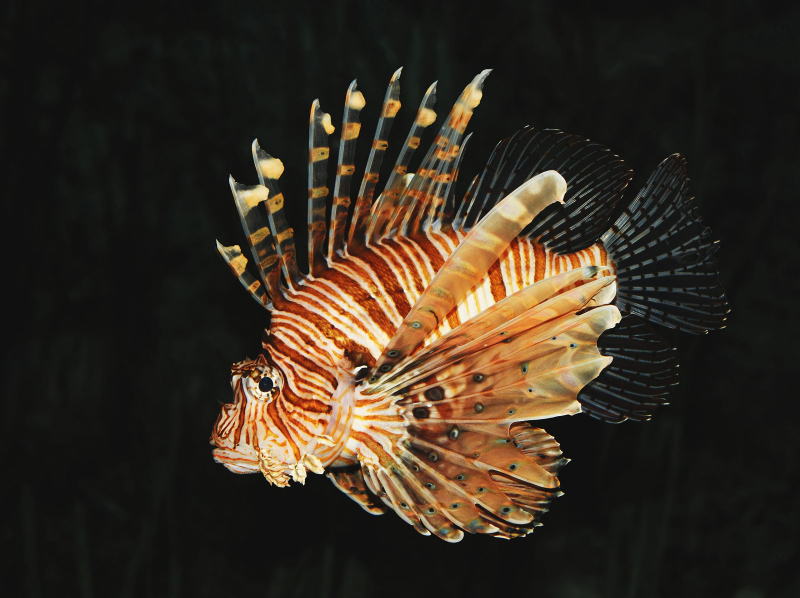
Photo: wikipedia 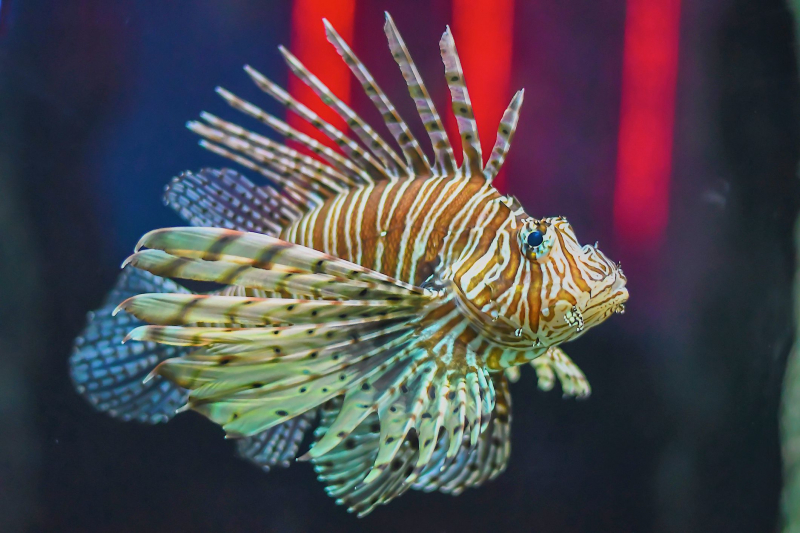
Photo: livingoceansfoundation.org -
Clownfish, also known as anemonefish, belong to the Amphiprioninae subfamily of fish. Clownfish are protandrous hermaphrodites, which means that some of them transition to female later in life. They are among the most beautiful saltwater fish in the world, but what makes them so remarkable is that they are all born male. The Indian and Pacific waters are home to anemonefish. Since they enjoy the warm water, reefs, lagoons, and shallow seas are where you'll typically find them.
These fish have a symbiotic relationship with the sea anemone, which serves as their home in return for the clownfish removing the anemone's parasites. Male clownfish are responsible for protecting the young in their hierarchical communities. Finding Nemo, a well-known Pixar-Disney picture, made clownfish widely known. Ocellaris clownfish make up Nemo and Marlin's characters. Some clownfish are yellow, pink, red, or black; not all clownfish are orange and white.
Clownfish can consume undigested food from their host anemones since they are omnivorous, and the sea anemone receives nutrients from the feces of the anemonefish. With the exception of Amphiprion perideraion, which mostly consumes algae, anemonefish primarily consume small zooplankton from the water column, such as copepods and tunicate larvae, with a small amount of their diet coming from algae.
Kingdom: Animalia
Phylum: Chordata
Class: Actinopterygii
Family: Pomacentridae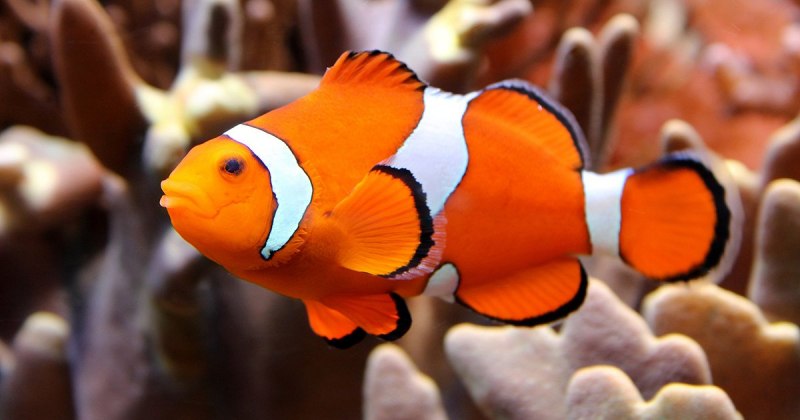
Photo: heanimalfacts.com Video: https://www.youtube.com/watch?v=rn6R4ncd2OU -
The Banggai cardinalfish is a diminutive tropical cardinalfish that belongs to the Apogonidae family. There is only one member of its genus. This stunning fish is well-liked in the aquarium industry. A significant number of them are still collected in the wild, making it an endangered species, despite being one of the very few marine fish that have been regularly bred in captivity. The spread of specific lethal illnesses and the damage that humans are causing to the environment are threats to the population of this species. Iridovirus infections are recognized to play a substantial role in fish mortality.
The Indonesian Banggai Islands are home to the little tropical fish known as the Banggai cardinalfish. They live in shallow settings like seagrass beds and coral reefs. They stand out for their gorgeous hues and striped and dot designs. Due to the aquarium trade, bangai cardinalfishes are currently in danger of extinction. These fish are an endangered species because a substantial portion of them are caught in the wild.
This fish is both graceful and gorgeous, both physically and behaviorally. The Banggai cardinalfish exudes a majestic and refined air as though it were a creature from a mythical past.
Kingdom: Animalia
Phylum: Chordata
Class: Actinopterygii
Family: Apogonidae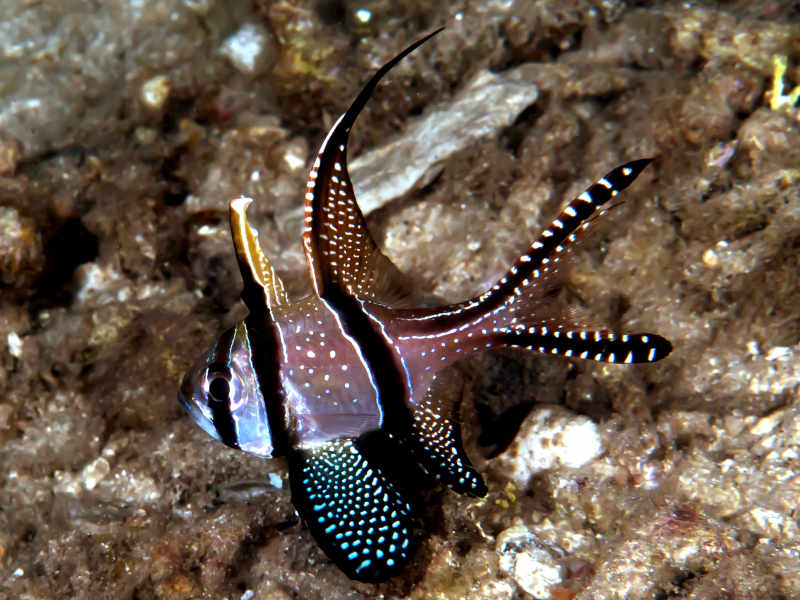
Photo: wikimedia commons 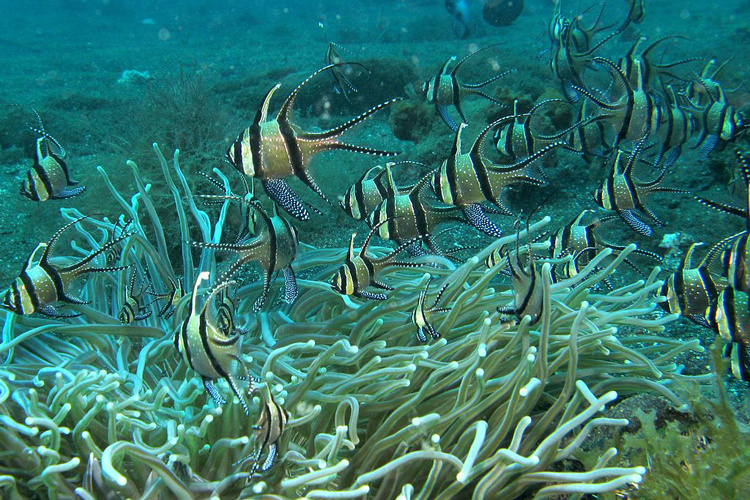
Photo: fisheries.noaa.gov -
The next position on the list of the most beautiful fishes in the world is the Siamese Fighting Fishes. The betta also referred to as the Siamese fighting fish, is a freshwater fish that is indigenous to Southeast Asia, including Cambodia, Laos, Myanmar, Malaysia, Indonesia, Thailand, and Vietnam. Due to their widespread appeal as pets and their comparatively low maintenance requirements, Betta splendens are among the most widely kept aquarium fish in the world. There are 73 species in the genus Betta, but only one is given the name "betta".
They are indigenous to the Mekong basin, which includes Thailand, Cambodia, and Vietnam, but are most frequently observed in Thailand's Chao Phraya river. This species is present in floodplains, rice paddies, and canals with standing water. Siamese fighting fish are known for their stunning, vivid colors and graceful fins. They come in a range of colors, including black, green, blue, red, orange, and yellow.
The longest of any fish, Siamese fighting fish are unique to the central plain of Thailand, where they have domesticated for the first time at least 1,000 years ago. They were originally bred for ferocity and used in cockfight-style gambling contests. Theodore Cantor, a Danish doctor, biologist, and botanist, is reported to have received some Bettas from King Rama III (1788–1851), who is credited with introducing them to the rest of the world.
Kingdom: Animalia
Phylum: Chordata
Class: Actinopterygii
Family: Osphronemidae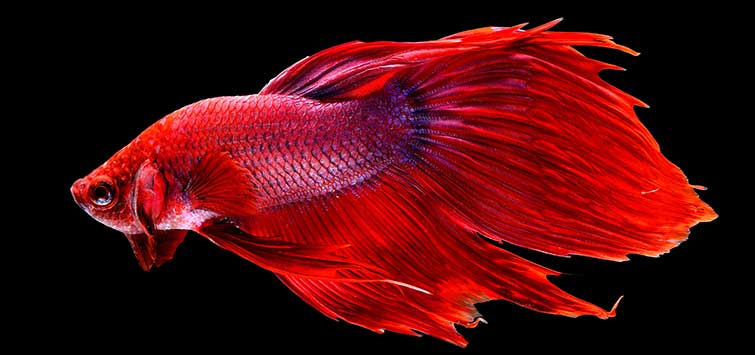
Photo: tfhmagazine.com 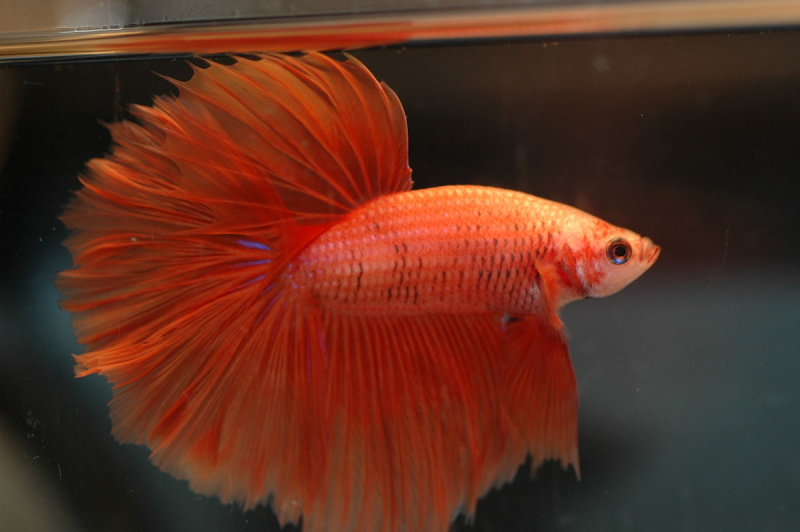
Photo: wikipedia -
The royal angelfish, also known as the regal angelfish, is a species of marine ray-finned fish and a marine angelfish that is a member of the monotypic genus Pygoplites and family Pomacanthidae. Oceans in the tropical Indo-Pacific contain it. It can reach a length of 25 cm.
The Indo-Pacific region has a vast distribution of royal angelfish. The species can be found in the Red Sea and Indian Ocean, extending from the Tuamoto Islands, New Caledonia, and the Great Barrier Reef to East Africa and the Maldives. The southern East China Sea, near Taiwan, Japan's Ryukyu Islands, and the Ogasawara Islands, is where the range's northernmost borders are located.
The royal angelfish has a limited commercial application in the aquarium business and is thought to be safe for humans. The fact that it eats mostly sponges and not corals makes it one of the few "reef safe" angelfish, which is prized by aquarium hobbyists. The royal angelfish can be difficult to keep in captivity, but with the correct environment and a range of live, frozen, flake, or freeze-dried foods to tempt satiety, a healthy individual is likely to start feeding within days. An unfriendly atmosphere will obstruct feeding and acclimatization efforts. Therefore, it is best to stay away from huge angelfish, triggerfish, puffers, as well as any too aggressive surgeonfish and clownfish.
Kingdom: Animalia
Phylum: Chordata
Class: Actinopterygii
Family: Pomacanthidae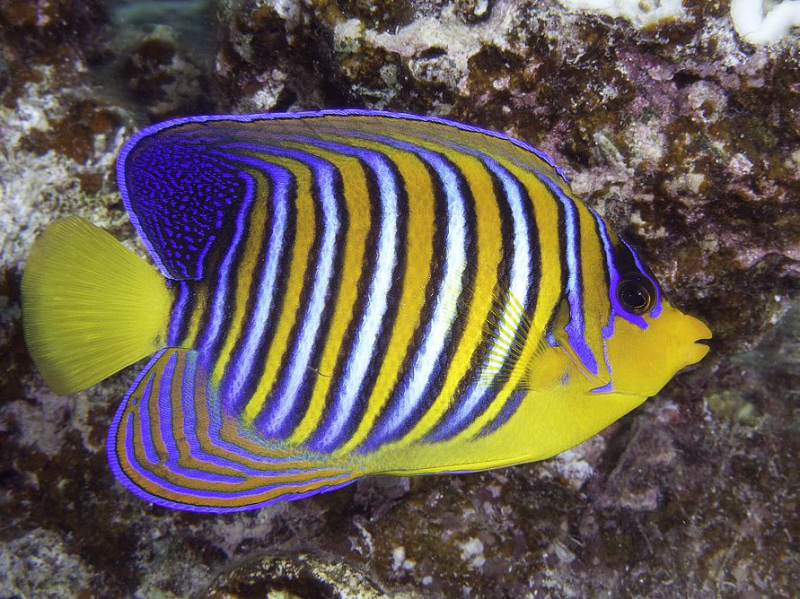
Photo: thesprucepets.com 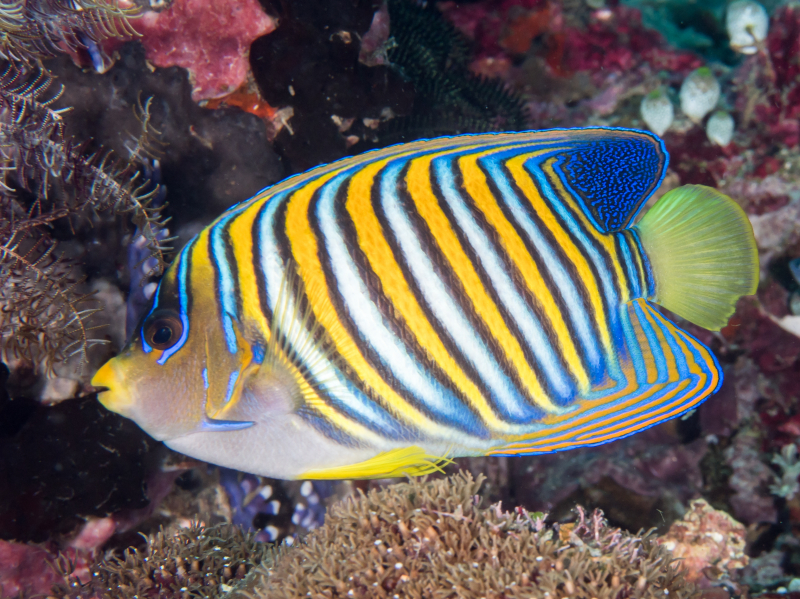
Photo: wikipedia -
The Indo-shallow Pacific's waters are home to Blueface angelfishes. The Maldives, Malaysia, Indonesia, Japan, Taiwan, Philippines, Micronesia, and northern Australia are among the islands where coral reefs with them are most frequently found.
The fish's name derives from the startling blue coloring of its face features. It is without a doubt one of the most exquisite fishes in existence. The Blueface Angelfish is an intriguing species to grow since they undergo such significant life-cycle changes. The young that are often offered is approximately an inch long, but they can develop into adults who are over a foot tall.It's a really participatory task to feed them. As omnivores, they will consume meatier frozen foods like shrimp, but they should also be provided angelfish feed and spirulina. To supplement their nutrition, it's crucial to promote moderate algae development in your tank. They will eat whatever naturally grows in the tank, but you can buy them algae pills or wafers as well. Since they do conceal, they do require feeding frequently - up to three times each day - but this merely increases the chance for interaction.
Kingdom: Animalia
Phylum: Chordata
Class: Actinopterygii
Family: Pomacanthidae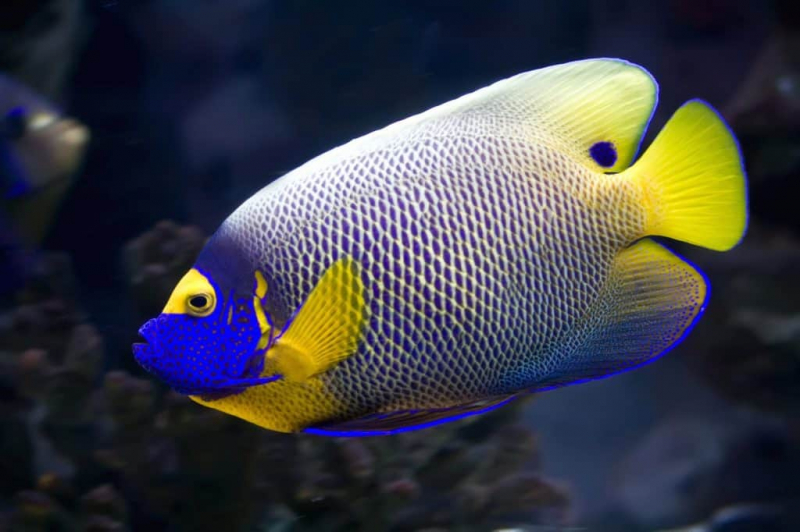
Photo: fishlaboratory.com Video: https://www.youtube.com/watch?v=h62vu-6hFP4 -
The fish genus Solenostomus belongs to the family Syngnathiformes and is often referred to as the ghost pipefish, fake pipefish, or tube mouth fish. The family Solenostomidae contains only one genus, Solenostomus, which is home to six currently identified species. Seahorses and pipefish are relatives of ghost pipefish. They can be found in the Indo-tropical Pacific waters.
The mouths of the animals, none of which are longer than 17 centimeters, are looking downward as they float practically motionlessly against a background that makes it difficult to view them. Through their long nose, they consume microscopic crustaceans for food. Except for while reproducing, when they seek out a coral reef or muddy bottom, they spend their lives in open waters. To reduce visibility, they change their color and shape.
They resemble pipefishes in many ways but can be recognized by the inclusion of pelvic fins, a pronounced, spiny dorsal fin, and star-shaped skin plates. Unlike true pipefish, female ghost pipefishes brood their eggs until they hatch using their enlarged pelvic fins.
Kingdom: Animalia
Phylum: Chordata
Class: Actinopterygii
Family: Solenostomidae
Photo: wikipedia 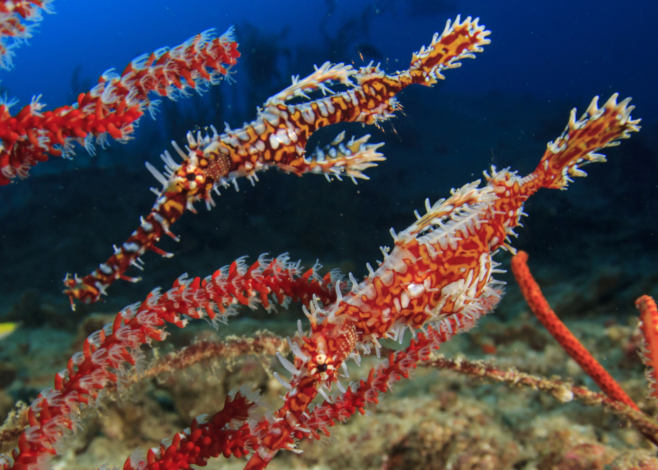
Photo: scubadiverlife.com -
A type of marine angelfish is the emperor angelfish. It is a fish that lives near reefs and is found in the Red Sea, the Indian and Pacific Oceans, Hawaii, and the Austral Islands. This species typically has steady numbers and is not endangered in any significant ways. Because of its distinctive, vivid pattern of colors, it is a favorite among photographers, artists, and aquarists.
The emperor angelfish exhibits a clear distinction between its juvenile and adult forms. The bodies of the juveniles are dark blue with concentric curving lines that alternate between pale blue and white, the smallest of which are placed posteriorly and are totally encased within one another. At the front, these lines are vertical. The caudal fin is transparent, while the border of the dorsal fin is white.
The adults have a light blue face with a dark blue mask covering their eyes, horizontal blue and yellow stripes, and a yellow caudal fin. Above the pectoral fins, there is a blackish band, the top of which is above the level of the upper orbit. This band's front and back margins are both a vivid blue and a narrow yellow line, respectively. The anal fin bears a horizontal pattern of lighter blue stripes on a dark blue background.
Kingdom: Animalia
Phylum: Chordata
Class: Actinopterygii
Family: Pomacanthidae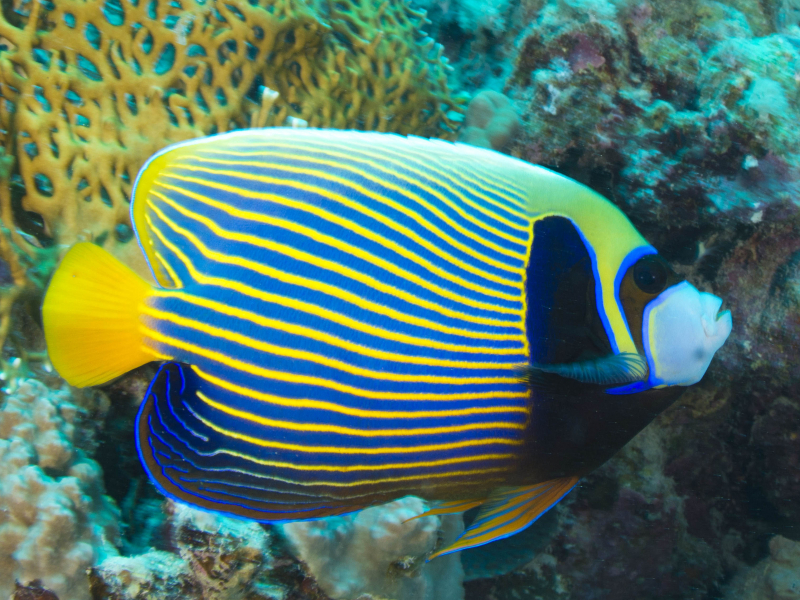
photo: wikipedia 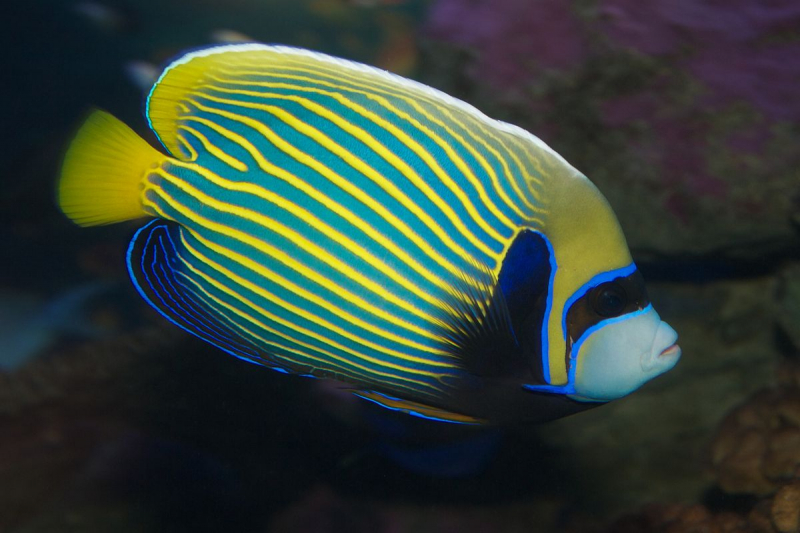
Photo: wikipedia -
The lagoon triggerfish, also called the black bar triggerfish, Picasso triggerfish, or Picassofish is an Indo-Pacific reef-dwelling triggerfish that may grow to a length of 30 cm.
The lagoon triggerfish inhabit coral reefs and their sandy surrounds, where they feed on a variety of organisms, primarily invertebrates and reef algae. They constantly move about restlessly and fiercely defend their territory from outsiders, including divers, particularly when guarding their eggs during the breeding season. They are significantly less harmful than the larger titan triggerfish in the same family due to their comparatively tiny size.
The fish may move more precisely through the water by using its dorsal and anal fins to make wave motions. It may move forward, backward, or just hover above the reef using these motions. This implies that compared to other unidirectional fish, it can back out of crevices more readily. Both sexes protect territories, and some do so for eight years or more. The usual male mating system is classified as haremic, although little is known about it. A typical male territory may overlap with one to five female territories. A new fish quickly takes over a male or female's territory if it is removed or gone. Over the course of their existence, they procreate frequently.
Kingdom: Animalia
Phylum: Chordata
Class: Actinopterygii
Family: Balistidae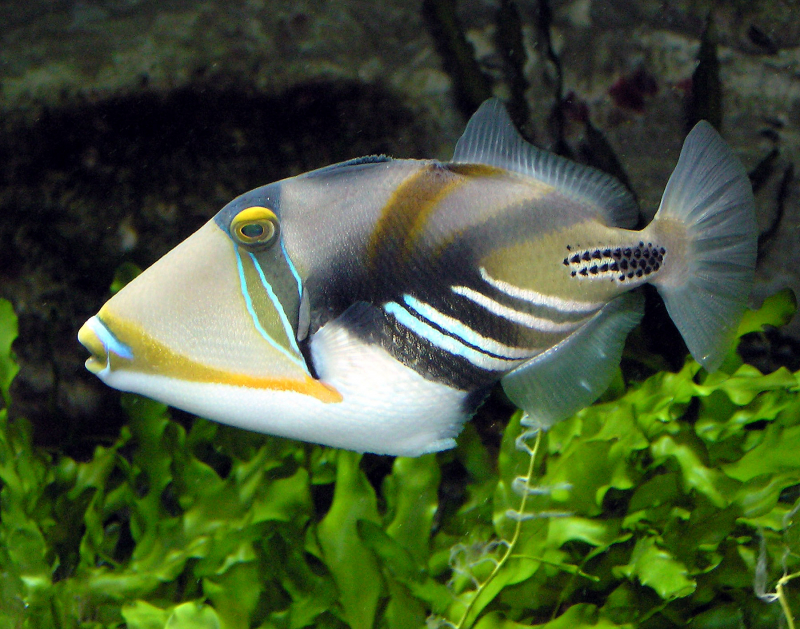
Photo: wikipedia 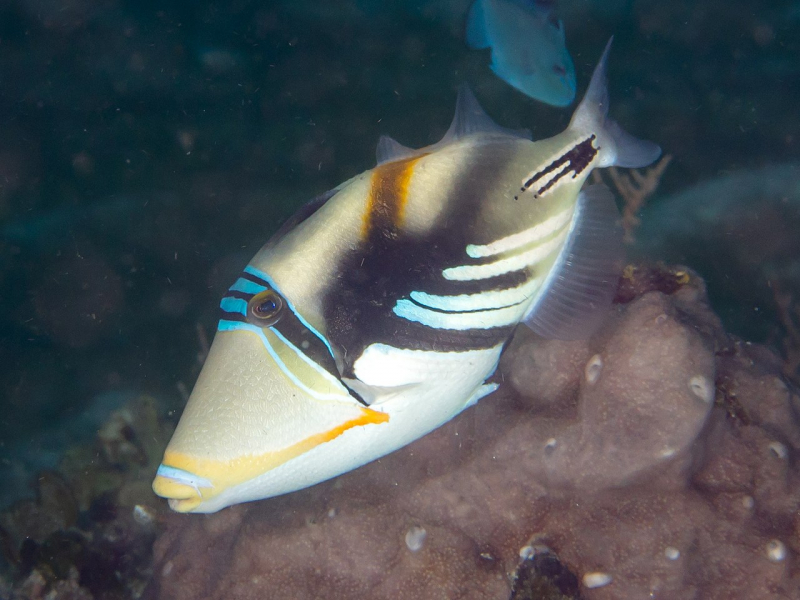
Photo: wikimedia commons -
One of the most beautiful fishes in the world is the mandarinfish, sometimes known as a mandarin dragonet, is a small, vividly colored member of the family of dragonets that is well-liked in the saltwater aquarium industry. The native range of the mandarinfish is in the Pacific, roughly from the Ryukyu Islands south to Australia. It frequently inhabits some of the warmer seas.
The feathery fins and vivid colors of this magnificent saltwater species, which is relatively little and almost phosphorescent in appearance, make it stand out. The charming dragonet and the mandarinfish are the only two animals that are truly blue.
Mandarinfish enjoy enticing us with their vibrant orange, yellow, green, and purple designs just as much as they enjoy dressing in blue. The mandarinfish is found in the Pacific Ocean, particularly in Australia's northernmost regions. Due to its residence on coral reefs, it has vibrant hues. It blends in with its vibrant surroundings since it is cautious and only emerges at night when it is necessary. Mandarinfish are well-liked in the aquarium trade, but because of their finicky feeding habits, they are thought to be challenging to maintain. While some fish never adjust to aquarium living and only consume live copepods and amphipods, those that do are said to be exceptionally resilient and highly resistant to illnesses like marine ich.
Kingdom: Animalia
Phylum: Chordata
Class: Actinopterygii
Family: Callionymidae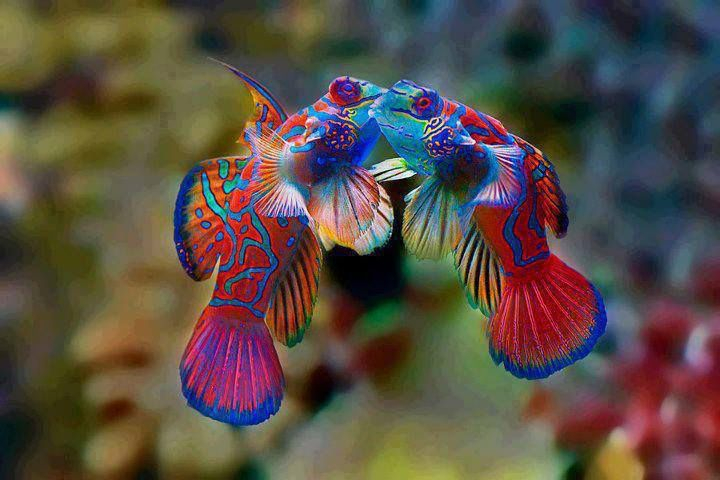
Photo: pinterest.at Video: https://www.youtube.com/watch?v=KivINH0ka_A -
One of the most beautiful fishes in the world is the French angelfish species known as the marine angelfish a type of ray-finned fish in the Pomacanthidae family. The body of the French angelfish is almost round and laterally compressed. The deep head has a short snout that ends in a tiny mouth with several bristle-like teeth. There is no spine on the operculum or under the eye, but there is a clear spine at the corner of the preoperculum.
The anal fin has three spines and 22–24 soft rays, compared to the dorsal fin's ten spines and 29–31 soft rays. The longest overall length for this species is 41.1 centimeters. The juveniles are almost all black save from five curved vertical yellow bands on the body, the first one at the mouth and the last one at the caudal peduncle. The caudal fin's edges are yellow. The adults are primarily black as well, however, the edges of the majority of the body scales are golden-yellow. They have a golden orbit and white lips. The dorsal fin has a long yellow filamentous extension coming from its soft-rayed portion, while the pectoral fins have a broad orange-yellow band.
Kingdom: Animalia
Phylum: Chordata
Class: Actinopterygii
Family: Pomacanthidae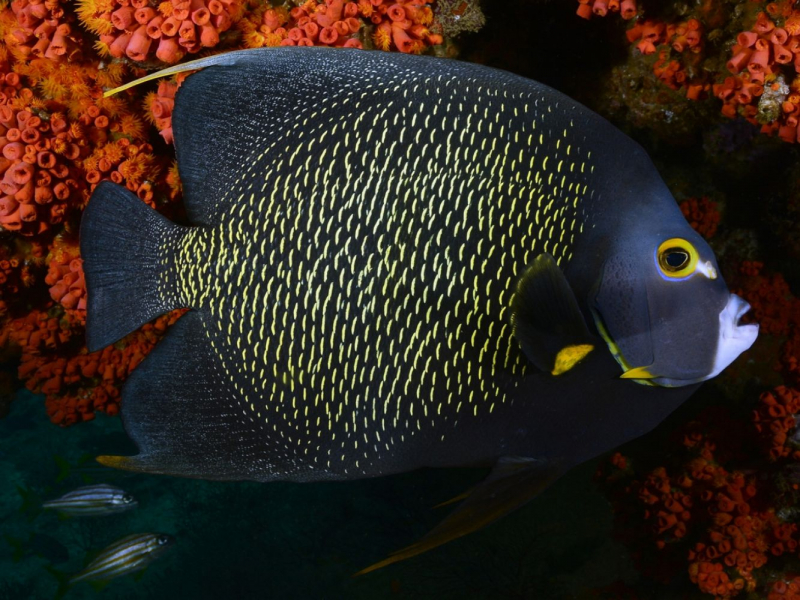
Photo: thoughtco.com Video: https://www.youtube.com/watch?v=B6wG8da-ils
































